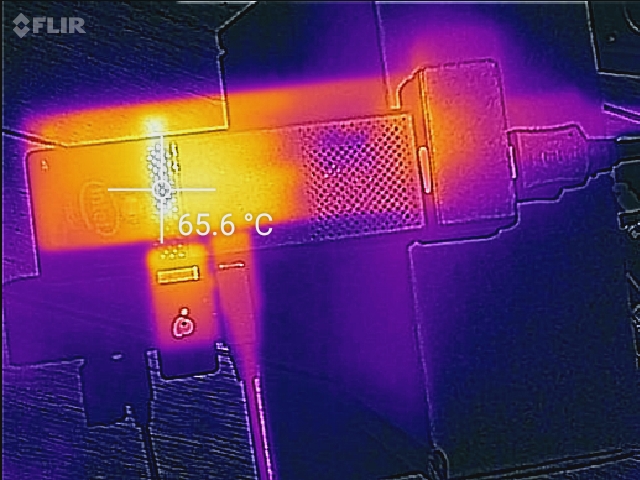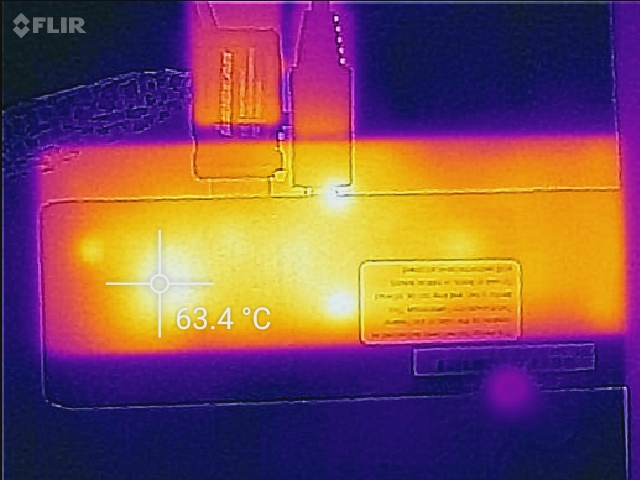The Intel Compute Stick (Cherry Trail) Review
by Ganesh T S on January 14, 2016 8:00 AM EST- Posted in
- Systems
- Intel
- Cherry Trail
- HDMI Stick
- CES 2016
- Compute Stick
Power Consumption and Thermal Performance
The power consumption at the wall was measured with a 1080p display being driven through the HDMI port. In the graphs below, we compare the idle and load power of the Intel PPSTK1AW32SC with other low power PCs evaluated before. For load power consumption, we ran Furmark 1.15.0 and Prime95 v28.7 (32-bit) together.


Compared to the Bay Trail Compute Stick, the Cherry Trail one has higher idle and load power consumption numbers. Given the upgraded Wi-Fi, the idle number can probably be justified. The load number is more due to the upgraded GPU which delivers much better performance while also consuming as much power as possible while staying within the acceptable thermal envelope.
Our thermal stress routine starts with the system at idle, followed by 30 minutes of pure CPU loading. This is followed by another 30 minutes of both CPU and GPU being loaded simultaneously. After this, the CPU load gets removed, allowing the GPU to be loaded alone for another 30 minutes. The various clocks in the system as well as the temperatures within the unit are presented below.
According to the official specifications, the junction temperature of the Atom x5-Z8300 is 90 C. The thermal solution is able to keep all temperatures around the 80C mark without excessive throttling. In the absence of any GPU loading, the CPU cores maintain a 1.6 GHz speed. We didn't observe the cores operating at the maximum burst frequency at all (1.84 GHz). With GPU loading into the picture, the cores can drop down to as low as 900 MHz even with the CPU load active. The GPU shunts between 380 MHz and 500 MHz depending on the load and available thermal headroom. One disappointing aspect is that the idling temperature of 57 C for the CPU cores is a lot higher than what we would like.
Using the Android version of the FLIR One thermal imager, we observed the chassis temperature after the CPU package temperature reached the steady state value in the above graph.
We see that the chassis remains below 66 C even when the internal SoC is at 80 C.














80 Comments
View All Comments
Gunbuster - Thursday, January 14, 2016 - link
Yeah okay, plugs into HDMI, guess what people have... 4K TV's.easp - Thursday, January 14, 2016 - link
No, most people don't have 4K TVs and aren't rushing to buy them. Sorry. You see, you can't both have bragging rights for buying the latest and greatest and claim that everyone has them.kaesden - Thursday, January 14, 2016 - link
its a shame there isn't a power over HDMI standard for devices like this so they could exist with no wires and just plug into a tv or monitor and be done with it.Visual - Thursday, January 14, 2016 - link
And also USB over HDMI so you can use the TV's USB ports for extra storage etc...And while we are at it, make the TV expose its tuners and CI slot for use by the stick as well.
icrf - Thursday, January 14, 2016 - link
MHL is the closest we get. I don't know that many TVs have it. I think one of the ports on my receiver does. I think the Roku streaming stick uses it.Visual - Thursday, January 14, 2016 - link
What are the odds we soon get a TV that's got one of these things built-in instead of sticking out? Lots already run Android or such, why not switch to x86 and full Windows?Visual - Thursday, January 14, 2016 - link
(tho I do appreciate the mobility aspect of a stick too)easp - Thursday, January 14, 2016 - link
And upgradability...Bull Dog - Thursday, January 14, 2016 - link
"Netflix streaming evaluation was done using the Windows 8.1 Netflix app."Should that read the Windows 10 Netflix app?
ganeshts - Thursday, January 14, 2016 - link
Thanks for pointing out the typo - it is fixed now.